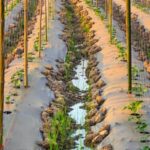Bees play a crucial role in pollinating vegetable gardens, which directly impacts crop yield and supports biodiversity. The process of pollination, carried out by bees, is essential for the successful growth of many vegetables and contributes to the overall health of our ecosystem. Understanding the specific role of bees in vegetable gardens, the types of bees involved, and how to support their presence is vital for gardeners and farmers alike.
As pollinators, bees facilitate the transfer of pollen from one flower to another, enabling the production of seeds and fruits in vegetable plants. This process directly impacts the growth and quality of vegetables, making bee pollination a key factor in agricultural productivity. Additionally, the presence of bees in vegetable gardens contributes to biodiversity by supporting the reproduction of various plant species, ultimately creating a more diverse and resilient ecosystem.
In this article, we will explore the importance of bees in pollinating vegetable gardens and delve into the specific role they play in this essential process. We will also discuss different types of bees involved in vegetable garden pollination and provide insights on how to create a bee-friendly environment to support their presence.
Furthermore, we will address potential threats to bee pollination and highlight the benefits it offers for both crop yield and biodiversity. Join us as we uncover the significant impact that bees have on our vegetable gardens.
The Role of Bees in Vegetable Gardens
The Process of Pollination
Pollination is a crucial step in the reproductive process of flowering plants, including many vegetables grown in gardens. Bees play a significant role in this process by transferring pollen from the male to the female parts of flowers. When bees collect nectar and pollen from flowers, they inadvertently pick up pollen grains, which they then transfer to other flowers as they forage. This transfer of pollen is essential for fertilization and the production of fruits and seeds.
Impact on Vegetable Growth
Without proper pollination, many vegetable plants would not be able to produce fruit or seeds. Incomplete or inadequate pollination can result in misshapen or underdeveloped fruits, affecting crop yield and quality. Additionally, some vegetables rely on cross-pollination between different plants to set fruit, making the presence of pollinators such as bees even more crucial for successful vegetable gardening.
The Significance of Bee Pollination
The role of bees in pollinating vegetable gardens extends beyond simply facilitating plant reproduction. The presence of bees promotes biodiversity and ecosystem health by supporting the growth of various vegetable crops. Furthermore, bee pollination enhances the resilience and sustainability of vegetable gardens by contributing to increased crop yields and overall garden productivity.
Overall, understanding the specific role that bees play in pollinating vegetable plants is essential for appreciating their significance in maintaining healthy and productive vegetable gardens.
Types of Bees
When it comes to pollinating vegetable gardens, various types of bees play a crucial role in ensuring the successful growth and yield of crops. Understanding the different types of bees and their specific contributions to pollination can help gardeners create a more bee-friendly environment and promote the health of their vegetable plants.
Honey Bees
Honey bees are perhaps the most well-known pollinators, and they play a significant role in pollinating vegetable gardens. These social insects collect nectar and pollen from flowers as food for the entire colony, inadvertently transferring pollen from one flower to another in the process. Their efficient foraging behavior makes them valuable pollinators for a wide range of vegetables, including tomatoes, peppers, and eggplants.
Bumblebees
Bumblebees are also important pollinators for vegetable gardens due to their ability to perform buzz pollination. This unique behavior involves the bee vibrating its flight muscles at a specific frequency, releasing pollen from flowers that require such action for effective pollination. Vegetables such as tomatoes, peppers, and blueberries greatly benefit from buzz pollination by bumblebees.
Mason Bees
Mason bees are solitary bees known for their efficient pollination of early spring fruits and vegetables. These gentle insects do not produce honey but are excellent pollinators due to their ability to carry large amounts of dry pollen on their abdomen rather than on hairy bodies or legs like other bee species. Because mason bees are active early in the season when many vegetables are blooming, they contribute significantly to crop yield in vegetable gardens.
By understanding these different types of bees and their roles in pollinating vegetable gardens, gardeners can take steps to attract and support these vital insects in their own growing spaces. Creating diverse habitats with suitable nesting sites and providing a variety of flowering plants can help ensure that vegetable plants receive the necessary bee visitation for successful pollination and healthy crop production.
Bee-Friendly Vegetables
When it comes to vegetable gardens, bees play a crucial role in the pollination process, influencing the growth and yield of various crops. Certain vegetables specifically rely on bee pollination for successful growth, as they require the transfer of pollen from the male to female flower parts in order to produce fruits.
Understanding which vegetables are dependent on bee pollination can help gardeners create a more bee-friendly environment and ensure a bountiful harvest. Here are some of the key vegetables that rely on bees for pollination:
- Tomatoes: Tomatoes are self-pollinating, but they benefit from buzz pollination, which is performed by bumblebees. This type of pollination is essential for tomato plants to set fruit properly and produce high-quality tomatoes.
- Cucumbers: Cucumbers depend on bees for pollination, as they have separate male and female flowers. Bees transfer pollen from the male flower to the female flower, leading to successful fruit development.
- Squash: Squash plants, including zucchini and pumpkins, rely heavily on bee pollination. The presence of bees is crucial for ensuring that squash flowers are effectively pollinated, resulting in healthy and abundant fruit production.
Incorporating these vegetable varieties into your garden not only provides delicious produce but also supports local bee populations. By understanding which vegetables require bee pollination, gardeners can take steps to attract and support bee activity within their gardens.
Creating a bee-friendly environment in your vegetable garden can be accomplished by incorporating certain practices:
- Planting a variety of bee-attractant flowers such as lavender, sunflowers, and coneflowers around or within the vegetable garden.
- Avoiding or minimizing pesticide use that can harm bees and other beneficial insects.
- Utilizing natural habitat features like wildflower fields or providing shelter options such as bee houses or nesting sites for solitary bees.
By consciously creating an environment that welcomes bees into the garden space, gardeners can cultivate a mutually beneficial relationship between their vegetable plants and local bees, ultimately contributing to sustainable gardening practices and healthy ecosystems.
Attracting Bees to Vegetable Gardens
Creating a bee-friendly environment in your vegetable garden is essential for promoting successful pollination and ensuring healthy plant growth. There are several tips and techniques that you can implement to attract bees to your garden, which will ultimately benefit the overall ecosystem and biodiversity of your gardening space.
One of the most effective ways to attract bees to your vegetable garden is by planting bee-friendly flowers. Bees are naturally drawn to nectar and pollen-rich blooms, so incorporating a variety of flowering plants in your garden will help to create an enticing habitat for these crucial pollinators.
Some excellent flower options that attract bees include lavender, sunflowers, asters, and bee balm. These flowers not only provide a food source for bees but also add beauty and color to your garden.
In addition to planting bee-friendly flowers, you can also use natural habitat features to attract bees. Creating nesting sites for solitary bees, such as mason bees, can help encourage their presence in your garden.
You can construct simple nesting blocks or houses using materials like bamboo or wood to provide these vital pollinators with a safe place to lay their eggs. Additionally, providing sources of water like shallow dishes or birdbaths can also be beneficial for attracting bees while helping them stay hydrated during the hot summer months.
| Beneficial Plants | Description |
|---|---|
| Lavender | Produces abundant nectar that attracts various types of bees. |
| Sunflowers | Large pollen-rich blooms that are highly attractive to bees. |
| Asters | Nectar-rich flowers that bloom late into the season, providing food for bees during the autumn months. |
| Bee Balm | This perennial herb produces showy flowers rich with nectar that are highly attractive to many species of bees. |
The Threats to Bee Pollination
One of the major challenges that bees face in pollinating vegetable gardens is the use of pesticides. These chemicals, which are often used to protect crops from pests, can be harmful to bees when they come into contact with them. Pesticides can affect bees in various ways, including causing disorientation, affecting their ability to forage for food, and even causing death.
The use of neonicotinoids, a type of pesticide, has been particularly concerning as it has been linked to declining bee populations. It is important for gardeners and farmers to be mindful of the potential impact of pesticides on bee pollination and explore alternative methods of pest control that are less harmful to these important pollinators.
In addition to pesticide use, habitat loss is another significant threat that bees face when it comes to pollinating vegetable gardens. As urbanization and agricultural expansion continue to encroach upon natural habitats, bees are losing critical foraging areas and nesting sites.
This loss of habitat can disrupt bee populations and make it challenging for them to find the resources they need to thrive. Creating bee-friendly environments within vegetable gardens by planting native flowers, providing nesting materials, and avoiding the use of chemical treatments can help mitigate the effects of habitat loss on bee pollination.
Furthermore, climate change poses a threat to bee pollination in vegetable gardens as shifts in temperature and weather patterns can affect the timing and availability of flowering plants. This can impact the synchronization between plant blooming and bee activity which is essential for successful pollination. It’s crucial for gardeners to be aware of these threats and take proactive measures to support healthy bee populations in their vegetable gardens.
| Threats | Impact |
|---|---|
| Pesticide Use | Harmful effects on bees such as disorientation, reduced foraging ability |
| Habitat Loss | Disruption of bee populations due to loss of foraging areas and nesting sites |
| Climate Change | Impacts timing and availability of flowering plants which affects successful pollination |
Benefits of Bee Pollination
Bees play a crucial role in pollinating vegetable gardens, and their contributions have a significant impact on crop yield and biodiversity. Understanding the benefits of bee pollination is essential for gardeners who want to support bee populations and ensure the successful growth of their vegetables.
The benefits of bee pollination for vegetable gardens are manifold and include increased crop yield, better quality produce, and a more diverse ecosystem. Here are some key advantages of bee pollination:
- Increased crop yield: Bees are efficient pollinators that help increase the fruit set and overall yield of many vegetable plants. By transferring pollen from one flower to another, bees facilitate the fertilization process, leading to a higher number of fruits or vegetables per plant.
- Better quality produce: Proper pollination results in healthier, more uniform fruits and vegetables. When vegetables are adequately pollinated, they develop larger sizes, more appealing shapes, and better taste. This is particularly important for crops such as tomatoes, cucumbers, and squash, which rely on bee pollination for successful growth.
- A more diverse ecosystem: Supporting bee populations in vegetable gardens contributes to a more diverse and resilient ecosystem. Bees also play a vital role in supporting other wildlife by contributing to the overall health and biodiversity of the garden environment.
Overall, understanding the benefits of bee pollination underscores the importance of creating a bee-friendly environment in vegetable gardens. By taking steps to attract bees and support their populations, gardeners can enhance the productivity and sustainability of their gardens while promoting biodiversity.
Conclusion
In conclusion, bees play a crucial role in pollinating vegetable gardens and are essential for the successful growth of many important vegetables. Without the pollination efforts of bees, crops like tomatoes, cucumbers, and squash would struggle to produce the high-quality fruits that we enjoy. It is clear that supporting bee populations is not only beneficial for the health of our vegetable gardens but also for the overall biodiversity of our environment.
It is important for gardeners and individuals alike to take action to support bee populations in their own gardens. By planting bee-friendly flowers and avoiding the use of harmful pesticides, we can create environments that are welcoming to bees and other pollinators. Additionally, providing natural habitat features such as nesting sites can further encourage bee populations to thrive.
In doing so, we can not only ensure the success of our own vegetable gardens but also contribute to the conservation of these vital pollinators. By working together to protect and support bees, we can safeguard the future of our food supply and promote a healthier, more diverse ecosystem for generations to come. So let us all do our part in protecting these important creatures which bees pollinate vegetable gardens.
Frequently Asked Questions
What Kind of Bees Pollinate Vegetables?
Different kinds of bees can pollinate vegetables, including honeybees, bumblebees, and solitary bees. Each type of bee has unique traits that make them effective pollinators for various vegetable plants.
What Are the Best Bees for Vegetable Garden?
The best bees for a vegetable garden are often native solitary bees or bumblebees because they are efficient at pollinating specific vegetables. Mason bees, in particular, are excellent pollinators for many vegetable plants due to their behavior and pollen-carrying capabilities.
What Are Pollinators in a Vegetable Garden?
Pollinators in a vegetable garden refer to the animals and insects that transfer pollen from the male parts of a flower to the female parts, leading to fertilization and fruit production. This includes not only bees but also butterflies, moths, beetles, and hummingbirds.

If you’re looking to get into vegetable gardening, or are just looking for some tips on how to make your current garden better, then you’ve come to the right place! My name is Ethel and I have been gardening for years. In this blog, I’m going to share with you some of my best tips on how to create a successful vegetable garden.





